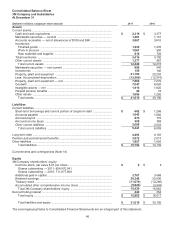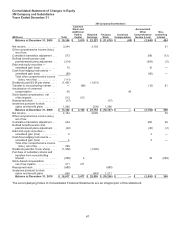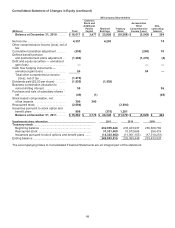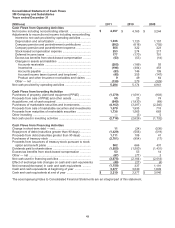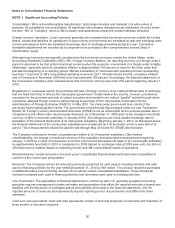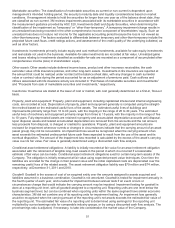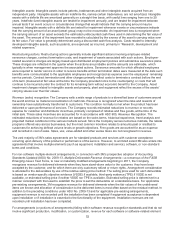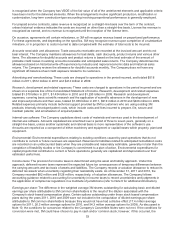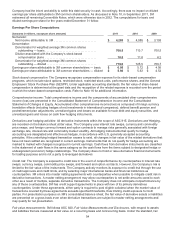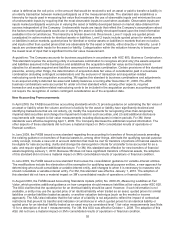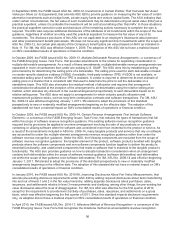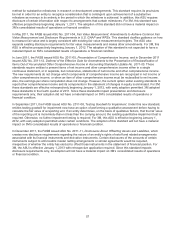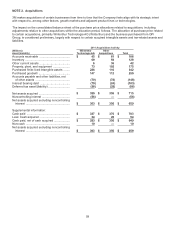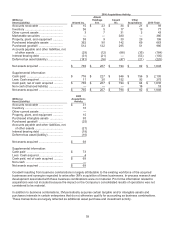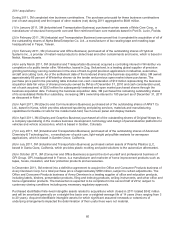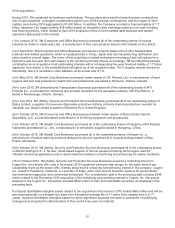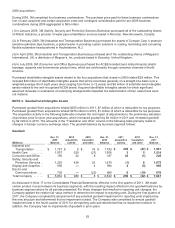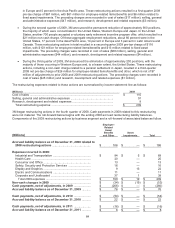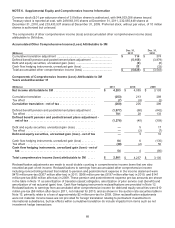3M 2011 Annual Report Download - page 62
Download and view the complete annual report
Please find page 62 of the 2011 3M annual report below. You can navigate through the pages in the report by either clicking on the pages listed below, or by using the keyword search tool below to find specific information within the annual report.
56
In September 2009, the FASB issued ASU No. 2009-12, Investments in Certain Entities That Calculate Net Asset
Value per Share (or Its Equivalent), that amends ASC 820 to provide guidance on measuring the fair value of certain
alternative investments such as hedge funds, private equity funds and venture capital funds. The ASU indicates that,
under certain circumstances, the fair value of such investments may be determined using net asset value (NAV) as a
practical expedient, unless it is probable the investment will be sold at something other than NAV. In those situations,
the practical expedient cannot be used and disclosure of the remaining actions necessary to complete the sale is
required. The ASU also requires additional disclosures of the attributes of all investments within the scope of the new
guidance, regardless of whether an entity used the practical expedient to measure the fair value of any of its
investments. The disclosure provisions of this ASU are not applicable to an employer’s disclosures about pension
and other postretirement benefit plan assets. 3M does not have any significant direct investments within the scope of
ASU No. 2009-12, but certain plan assets of the Company’s benefit plans are valued based on NAV as indicated in
Note 11. For 3M, this ASU was effective October 1, 2009. The adoption of this ASU did not have a material impact
on 3M’s consolidated results of operations or financial condition.
In October 2009, the FASB issued ASU No. 2009-13, Multiple-Deliverable Revenue Arrangements²a consensus of
the FASB Emerging Issues Task Force, that provides amendments to the criteria for separating consideration in
multiple-deliverable arrangements. As a result of these amendments, multiple-deliverable revenue arrangements are
separated in more circumstances than under pre-existing U.S. GAAP. The ASU does this by establishing a selling
price hierarchy for determining the selling price of a deliverable. The selling price used for each deliverable is based
on vendor-specific objective evidence (VSOE) if available, third-party evidence (TPE) if VSOE is not available, or
estimated selling price if neither VSOE nor TPE is available. A vendor is required to determine its best estimate of
selling price in a manner that is consistent with that used to determine the price to sell the deliverable on a
standalone basis. This ASU also eliminates the residual method of allocation and requires that arrangement
consideration be allocated at the inception of the arrangement to all deliverables using the relative selling price
method, which allocates any discount in the overall arrangement proportionally to each deliverable based on its
relative selling price. The ASU does not apply to arrangements for which industry specific allocation and
measurement guidance exists, such as long-term construction contracts and software transactions. For 3M, ASU
No. 2009-13 was effective beginning January 1, 2011. 3M elected to adopt the provisions of this standard
prospectively to new or materially modified arrangements beginning on the effective date. The adoption of this
standard did not have a material impact on 3M’s consolidated results of operations or financial condition.
In October 2009, the FASB issued ASU No. 2009-14, Certain Revenue Arrangements That Include Software
Elements²a consensus of the FASB Emerging Issues Task Force, that reduces the types of transactions that fall
within the scope of software revenue recognition guidance. Pre-existing software revenue recognition guidance
required that its provisions be applied to an entire arrangement involving the sale of any products or services
containing or utilizing software when the software was considered more than incidental to the product or service. As
a result of the amendments included in ASU No. 2009-14, many tangible products and services that rely on software
are accounted for under the multiple-element arrangements revenue recognition guidance rather than under the
software revenue recognition guidance. Under the ASU, the following components are excluded from the scope of
software revenue recognition guidance: the tangible element of the product, software products bundled with tangible
products where the software components and non-software components function together to deliver the product’s
essential functionality, and undelivered components that relate to software that is essential to the tangible product’s
functionality. The ASU also provides guidance on how to allocate transaction consideration when an arrangement
contains both deliverables within the scope of software revenue guidance (software deliverables) and deliverables
not within the scope of that guidance (non-software deliverables). For 3M, ASU No. 2009-14 was effective beginning
January 1, 2011. 3M elected to adopt the provisions of this standard prospectively to new or materially modified
arrangements beginning on the effective date. The adoption of this standard did not have a material impact on 3M’s
consolidated results of operations or financial condition.
In January 2010, the FASB issued ASU No. 2010-06, Improving Disclosures About Fair Value Measurements, that
amends pre-existing disclosure requirements under ASC 820 by adding required disclosures about items transferring
into and out of levels 1 and 2 in the fair value hierarchy; adding separate disclosures about purchases, sales,
issuances, and settlements relative to level 3 measurements; and clarifying, among other things, the pre-existing fair
value disclosures about the level of disaggregation. For 3M, this ASU was effective for the first quarter of 2010,
except for the requirement to provide level 3 activity of purchases, sales, issuances, and settlements on a gross
basis, which was effective beginning the first quarter of 2011. Since this standard impacts disclosure requirements
only, its adoption did not have a material impact on 3M’s consolidated results of operations or financial condition.
In April 2010, the FASB issued ASU No. 2010-17, Milestone Method of Revenue Recognition²a consensus of the
FASB Emerging Issues Task Force that recognizes the milestone method as an acceptable revenue recognition


